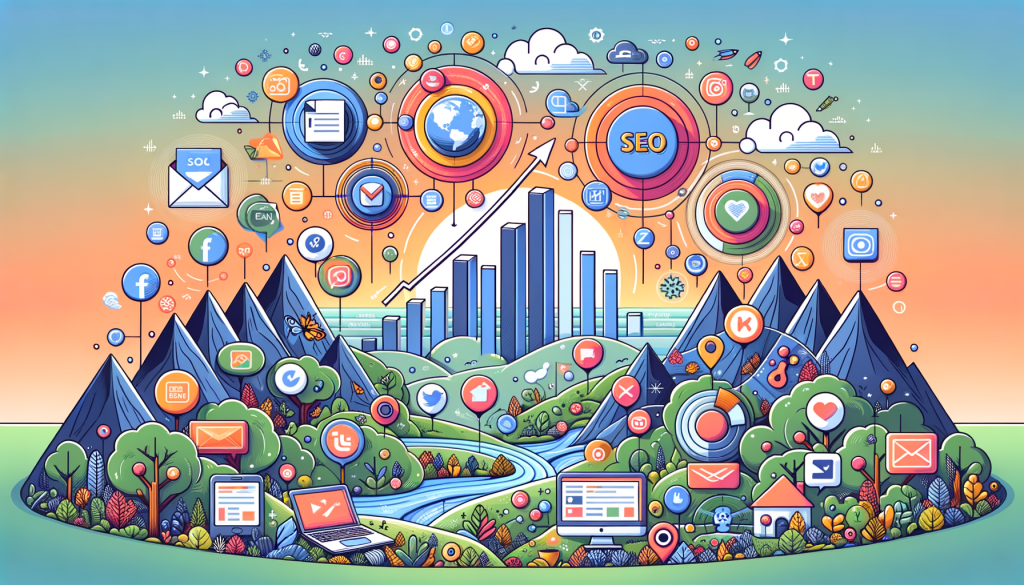Revolutionizing Consumer Engagement with Virtual Reality
Virtual reality (VR) has emerged as a powerful tool for revolutionizing consumer engagement in the field of marketing. With its immersive and interactive nature, VR allows brands to create unique and memorable experiences for their target audience. This technology has the potential to transform the way companies connect with consumers, enabling them to forge deeper emotional connections and drive brand loyalty.
One of the key advantages of VR in consumer engagement lies in its ability to transport individuals to virtual environments that replicate real-life scenarios. By putting consumers in the center of the action, brands can provide a more personalized and engaging experience. For example, a travel company can use VR to give potential customers a virtual tour of a destination, allowing them to explore hotels, attractions, and experiences without leaving their homes. This not only enhances the customer’s understanding of the product but also generates a sense of excitement and desire to engage further with the brand.
Furthermore, VR can be employed to create interactive product demonstrations and simulations. Brands can showcase their products in a virtual environment, allowing consumers to interact with them in ways that were previously impossible. Whether it’s test-driving a car, trying on virtual clothing, or experimenting with different home decor options, VR provides a realistic and immersive experience that enhances consumer understanding and decision-making.
In addition to its experiential benefits, VR also offers valuable data insights for marketers. By tracking users’ behavior and interactions within the virtual environment, brands can gain valuable insights into consumer preferences and interests. This data can then be used to tailor marketing strategies, improve product offerings, and enhance the overall customer experience.
Overall, VR has the potential to revolutionize consumer engagement in marketing by providing immersive, interactive, and personalized experiences. Brands that embrace this technology can differentiate themselves in the market, build stronger relationships with their customers, and drive business growth.
Enhancing Brand Experience through Immersive Virtual Reality
Virtual reality (VR) technology has revolutionized the way brands interact with their customers, offering a new level of engagement and immersion. By creating a virtual environment that users can explore and interact with, brands can enhance the overall brand experience and leave a lasting impression on their target audience.
One of the key advantages of using VR in marketing is the ability to transport users to different locations and scenarios, allowing them to experience a product or service in a completely immersive way. For example, a travel agency can use VR to give potential customers a virtual tour of a destination, allowing them to explore the sights and sounds before making a booking.
Furthermore, VR can also be used to create interactive product demonstrations, giving customers a hands-on experience without physically being present. This can be particularly useful in industries such as automotive or real estate, where customers can virtually test drive a car or take a virtual tour of a property.
Another benefit of VR in marketing is its ability to evoke emotions and create memorable experiences. By immersing customers in a virtual world, brands can create a sense of excitement, curiosity, or even fear, depending on the desired effect. This emotional connection can significantly impact brand perception and increase customer loyalty.
Moreover, VR can also be used as a tool to educate and inform customers about a brand or product. Brands can develop virtual training programs or tutorials to teach customers how to use their products effectively. This not only enhances the customer experience but also helps build trust and credibility.
In conclusion, VR has the potential to revolutionize marketing by providing a more immersive and engaging brand experience. From transporting users to different locations and creating interactive product demonstrations to evoking emotions and educating customers, VR offers endless possibilities for brands to leave a lasting impression on their target audience.
Leveraging Virtual Reality for Interactive Product Demonstrations
Virtual reality (VR) has revolutionized the way marketing professionals can showcase their products and engage with consumers. By leveraging VR technology, companies can create immersive and interactive product demonstrations that allow customers to experience their offerings in a whole new way.
One of the key advantages of using VR for product demonstrations is the ability to provide a realistic and detailed experience. With VR, customers can virtually interact with the product, explore its features, and even test its functionality. This level of realism helps potential customers develop a better understanding of the product and its benefits, leading to increased confidence and purchase intent.
Furthermore, VR allows for customization and personalization. Companies can create virtual environments that reflect their target customers’ preferences and needs. For example, a car manufacturer can offer customers the ability to virtually test drive different models, customize the interior and exterior, and experience various driving scenarios. This level of personalization helps customers envision themselves using the product and can significantly influence their purchase decisions.
Another advantage of leveraging VR for product demonstrations is its ability to reach a wider audience. With the increasing popularity of VR headsets and mobile VR platforms, companies can showcase their products to customers all over the world, without the need for physical presence. Virtual product demonstrations can be easily shared through online platforms, allowing potential customers to access them at their convenience and from any location.
In addition to the immersive experience, VR also offers valuable data and insights. Companies can track customers’ interactions within the virtual environment, analyze their behavior, and gain valuable insights into their preferences and needs. This data can be used to further optimize marketing strategies, tailor product offerings, and improve overall customer satisfaction.
In conclusion, leveraging VR for interactive product demonstrations is a powerful marketing tool that allows companies to provide realistic and personalized experiences to potential customers. By embracing this technology, companies can enhance their marketing efforts, reach a wider audience, and gain valuable insights into customer behavior.
Unleashing Creative Possibilities: Virtual Reality in Advertising
Virtual reality (VR) has emerged as a powerful tool in the world of advertising, offering unique and immersive experiences that captivate audiences like never before. With the ability to transport consumers to virtual worlds, VR has the potential to revolutionize marketing strategies by creating unforgettable brand interactions.
One of the key advantages of VR in advertising is its ability to evoke strong emotions and create a lasting impact on consumers. By immersing users in a virtual environment, brands can elicit feelings of excitement, curiosity, and even nostalgia, which can significantly enhance the effectiveness of their advertising campaigns.
Furthermore, VR allows brands to tell their stories in a more engaging and interactive manner. Instead of relying on traditional static images or videos, VR enables advertisers to create dynamic and interactive experiences that allow users to actively participate in the brand narrative. This not only increases brand engagement but also helps in building a deeper connection with the target audience.
Another benefit of VR in advertising is its ability to provide consumers with a firsthand experience of products or services. Whether it’s test-driving a car, trying on virtual clothes, or exploring a virtual store, VR allows consumers to fully experience and understand a product before making a purchase decision. This immersive experience not only boosts consumer confidence but also increases the likelihood of conversion, leading to higher sales and brand loyalty.
Additionally, VR opens up new possibilities for targeted advertising. By collecting user data and analyzing user behavior within the virtual environment, brands can gain valuable insights into consumer preferences and tailor their advertising content accordingly. This personalized approach not only increases the relevance of ads but also enhances the overall user experience.
In conclusion, virtual reality has the potential to transform the field of marketing by providing advertisers with a powerful tool to engage and captivate audiences. With its ability to evoke emotions, tell engaging stories, provide firsthand experiences, and enable targeted advertising, VR is revolutionizing the way brands connect with consumers and create lasting brand impressions.
Virtual Reality as a Tool for Market Research and Consumer Insights
Virtual reality (VR) has emerged as a powerful tool in market research and consumer insights, revolutionizing how companies gather data and understand consumer behavior. By immersing individuals in a simulated environment, VR offers a unique and realistic experience that can provide valuable insights into consumer preferences and decision-making processes.
One of the main advantages of using VR for market research is its ability to create highly controlled and customizable environments. Researchers can design virtual scenarios that mimic real-world situations, allowing them to observe and analyze consumer reactions in a controlled setting. This level of control enables researchers to isolate specific variables and test different scenarios, leading to more accurate and reliable results.
Furthermore, VR can also help researchers overcome some of the limitations of traditional market research methods. For instance, in traditional focus groups or surveys, participants may struggle to accurately recall their emotions or experiences. With VR, researchers can capture real-time data on participants’ emotional and physiological responses, providing a deeper understanding of their reactions.
Another significant advantage of using VR in market research is its ability to enhance consumer engagement and involvement. VR experiences can be highly immersive and interactive, capturing participants’ attention and allowing them to actively engage with products or services. This increased engagement can lead to more authentic responses and insights, as participants are more likely to behave naturally in a virtual environment.
Additionally, VR can also provide a cost-effective solution for market research. Traditional methods often involve significant expenses, such as renting venues, recruiting participants, and compensating them for their time. In contrast, VR research can be conducted remotely, eliminating the need for physical spaces and reducing overhead costs.
- Virtual Reality in Market Research:
- Creates controlled and customizable environments
- Allows for real-time capture of emotional and physiological responses
- Enhances consumer engagement and involvement
- Provides a cost-effective solution
In conclusion, virtual reality offers tremendous potential as a tool for market research and consumer insights. Its ability to create immersive, controlled environments, capture real-time data, enhance consumer engagement, and provide cost-effective solutions make it a valuable asset for companies seeking to understand and cater to their target market more effectively.
Overcoming Challenges and Harnessing the Potential of Virtual Reality Marketing
Virtual reality (VR) marketing has emerged as a powerful tool for businesses to engage with their customers in a unique and immersive way. However, like any new technology, it comes with its own set of challenges that marketers need to overcome in order to harness its full potential.
One of the key challenges of VR marketing is the high cost of development and implementation. Creating a VR experience requires specialized equipment and software, which can be expensive for businesses, especially small and medium-sized ones. Additionally, the production of high-quality VR content requires skilled professionals, further adding to the costs. Despite these challenges, the decreasing costs of VR technology over time are making it more accessible to businesses of all sizes.
Another challenge is the limited reach of VR experiences. While VR offers an incredibly immersive experience, it is still a niche technology that not everyone has access to. The adoption of VR headsets is still relatively low, and not all consumers are willing to invest in the necessary hardware. This limits the potential reach of VR marketing campaigns. However, as VR technology becomes more mainstream and affordable, its reach is expected to increase significantly.
Technical issues and compatibility are also hurdles that marketers need to address. VR experiences require powerful hardware to run smoothly, and not all devices meet the necessary requirements. This can lead to performance issues and a subpar user experience. Marketers need to ensure that their VR content is compatible with a wide range of devices to maximize its impact and reach a larger audience.
Despite these challenges, the potential of VR marketing is immense. It offers a level of immersion and interactivity that traditional marketing methods cannot match. VR can transport consumers to virtual environments, allowing them to explore products and services in a way that feels real and tangible. This has the potential to greatly influence purchasing decisions and create memorable brand experiences.
In conclusion, while there are challenges to overcome in harnessing the potential of VR marketing, the benefits it offers are worth the effort. As technology continues to advance and costs decrease, VR is expected to become a more accessible and mainstream marketing tool. Marketers who embrace VR early on and find innovative ways to leverage its capabilities will be able to stand out from the competition and create impactful experiences for their customers.






I recently experienced a virtual reality marketing campaign for a new car and it completely changed my perception of the product. The immersion was so engaging that I felt like I was really driving the car. I can see how this technology can revolutionize marketing strategies. But how accessible is this technology for smaller businesses with limited resources?
As a virtual reality enthusiast, I’ve been following the integration of VR in marketing closely. The ability to create interactive and personalized experiences for consumers is a game-changer. However, I’m curious about the potential ethical implications of using VR in marketing. How can companies ensure that the experiences are not manipulative or invasive?
I work in the marketing industry, and the impact of virtual reality cannot be overstated. We’ve seen a significant increase in consumer engagement and brand recall with VR campaigns. However, there are still challenges in measuring the ROI of VR marketing efforts. How can we effectively track and analyze the performance of VR campaigns?
I had the opportunity to try a virtual reality demo for a travel destination, and it was a game-changing experience. It felt like I was actually there, and it influenced my decision to book the trip. I’m interested in learning more about the potential reach of VR marketing – how can companies ensure that the experiences reach a wide audience?
Virtual reality has immense potential in creating memorable brand experiences. I believe it can bridge the gap between online and offline shopping experiences. However, I’m concerned about the cost of developing VR content for marketing. Are there cost-effective solutions available for businesses looking to explore VR marketing?
I’m fascinated by the possibilities of virtual reality in marketing. The ability to transport consumers into immersive brand experiences is groundbreaking. However, I wonder about the level of consumer acceptance and adoption of VR marketing. Are there any studies on consumer attitudes towards VR-based marketing initiatives?